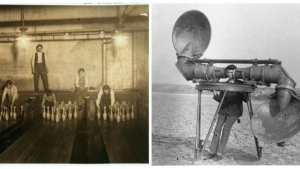11 unusual jobs that no longer exist today
Have you ever thought about who did all the jobs and tasks that are today performed by machines? Or about the jobs that humans do today, but will no doubt be replaced by technology at some point in the future? Here's a fascinating trip back in time to show you 11 jobs that no longer exist, but were once a reliable source of income for our ancestors!

1. Human radars

© Jeanbaptisteparis/Flickr.com

Before radars were invented, the military had to find a way to detect approaching enemy aircraft. The contraption they used were basically 'giant ears' that soldiers would wear in order to detect the sound of noisy engines as planes crisscrossed the skies. It was during the 1940's that radars and acoustic localization replaced these weird devices.
2. Orgy planner

The ancient Roman elite liked to party and used to employ people to not only organize their gargantuan feasts, but also more scandalous pleasures. Today we have the internet and other means to organize events, but back in the day it was up to a dedicated orgy organizer who didn't have a cell phone or Wi-Fi connection to hand. Petronius, a famous courtier who wrote Satiricon, was Nero's party planner, but he later committed suicide when his events ceased to please the emperor!
3. Armpit hair remover

Keeping with ancient Rome, a visit to the communal baths routinely ended with an armpit hair removal session - essential for anyone deemed good enough to be part of the ruling class. However, in this pre-waxing and laser era, an armpit hair remover would use red hot tweezers to keep their clients hairy armpits in check!
4. Burial clown

© The Public Domain Review/Wikimedia Commons
The history of clowns is fascinating! This job first appeared in ancient Roman culture, where a person would be employed to amuse grieving families and commemorate a deceased person. They would dress up as the deceased for their funeral and then proceed to do impressions, apparently much to the amusement of those present.
5. Toilet assistant

© Lobsterthermidor/Wikimedia Commons
King Henry VIII created a toilet assistant post so that he could be helped with his bowel functions. This disgusting job was undertaken by sons of the nobility who would accompany the king to the toilet and then wash and dress the monarch once he'd 'done his business'. During the Tudor era, this job evolved, with employees no longer limited to bathroom duties but also working as full-time 'dressers'.
6. Leech collectors

Up until the 19th Century applying leeches was a common treatment prescribed by doctors, so stocks needed to be available. It was usually women who would stand in swamps so that leeches attached themselves to their legs in order to suck out their blood. These leeches would then be delivered to doctors, although these poor employees often suffered from severe blood loss and serious infections.
7. Whipping boys

© Walter S. Stacey/Wikimedia Commons
These were children who were raised with young royals and who were punished instead of their princely 'friend'. At the time, teachers were employed to educate royal children, but were forbidden from handing out punishments when they misbehaved. Instead they would beat the 'whipping boy' in the hope that the young royal would suffer by proxy and stop being naughty.
8. Urine collectors

Another ancient Roman job was the urine collector. Urine was used to wash fabrics and these 'laundry maids' were employed to collect urine from the town's communal toilets!
9. Pinsetters

© Library of Congress Prints and Photographs Division Washington, D.C
Before bowling pins were mechanically set, people were employed to set up the pins and collect players' bowling balls. It was a poorly paid, physically draining, evening job that was usually done by teenage boys.
10. Lino typists

© Library of Congress Prints and Photographs Division Washington, D.C
A linotype was the machine that produced newspaper content. Qualified lino typists would enter the text and apply a technique called hot metal typesetting to speed up what was once a manual process. As technology advanced, this process was replaced by photo-composition or filmsetting.
11. Human calculators

From the 17th Century onwards people performed the tasks that are nowadays done by calculators and computers. Human calculators would handle any mathematical or engineering calculations - a long and arduous process that was later replaced with the arrival of computer technology.

By Straker Julia
Writer
Passionate about writing, I write articles on the subjects that I love. Creativity and Animals themes are my favorites!


